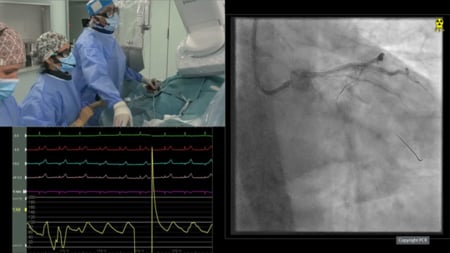26 Mar 2020
Stent thrombosis in patients with atrial fibrillation undergoing coronary stenting in the AUGUSTUS trial
Selected in Circulation by M. Alasnag
This analysis examines the incidence, timing, and characteristics of stent thrombosis and its outcomes in the AUGUSTUS cohort.
References
Authors
Lopes RD, Leonardi S, Wojdyla DM, Vora AN, Thomas L, Storey RF, Vinereanu D, Granger CB, Goodman SG, Aronson R, Windecker S, Thiele H, Valgimigli M, Mehran R, Alexander JH.
Reference
Circulation, March 3, 2020 Vol 141, Issue 9
Published
March 2020
Link
Read the abstractReviewer
My Comment
Why this study? – the rationale/objective
Interventional cardiologists frequently encounter a dilemma in patients who undergo percutaneous coronary angiography and have an indication for anticoagulation (commonly atrial fibrillation).
Several studies have been published on dual vs triple therapy with direct oral anticoagulants (DOAC) including the AUGUSTUS trial (Lopes, RD, Heizer, G, Aronson, R, Vora, AN, Massaro, T, Mehran, R, Goodman, SG, Windecker, S, Darius, H, Li, J, et al; AUGUSTUS Investigators. Antithrombotic therapy after acute coronary syndrome or PCI in atrial fibrillation. N Engl J Med. 2019;380:1509–1524).
The most recent guidelines have provided an algorithm addressing the duration of dual/triple therapy factoring in the presentation. Briefly, the European Society of Cardiology recommends that the default dual anti-platelet therapy (DAPT) duration is 12 months. Six-month duration can be considered in high bleeding risk patients, whereas >12-month therapy for patients presenting with an acute coronary syndrome (ACS) who can tolerate DAPT without a bleeding complication. There is growing evidence that bleeding risk supersedes thrombotic risk. However, ACS patients are often high risk for thrombosis particularly as the PCI becomes more complex involving bifurcations, long stented segments and multivessel PCI.
This analysis examines stent thrombosis in the AUGUSTUS cohort.
How was it executed? – the methodology
The incidence, timing, and characteristics of stent thrombosis and its outcomes in the AUGUSTUS cohort were examined.
The effects of low-dose aspirin (compared with placebo) and apixaban (compared with vitamin K antagonist (VKA) on stent thrombosis (ST) were also evaluated.
Patients included in this sub-study had PCI during the index admission whether the indication was ACS or chronic coronary artery disease. Patients who were treated medically (n=1097) or an unknown index event (n=19) were excluded.
What is the main result?
A total of 3498 patients who underwent PCI were analysed. The stent thrombosis rate was 1.6% (57 patients) at 6 months. The baseline characteristics of patients with and without ST were similar. Of these, 20 (0.6%) were definite, 10 (0.3%) probable, and 27 (0.8%) possible. The majority of these occurred within the first 30 days. Only 18 had coronary angiography to confirm the diagnosis. Fifteen involved drug-eluting stents, 1 bare-metal stent, and 2 were not specified. The ST occurred in the left anterior descending artery in 12 cases, right coronary artery in 3, left circumflex artery in 1, and an unspecified vessel in 2. Twenty-eight were on clopidogrel and 2 on ticagrelor.
In terms of outcomes, 21 had a new myocardial infarction, 16 required urgent revascularization (PCI or CABG) and 12 died. Stent thrombosis occurred in 13 (0.74%) of those on apixaban and 17 (0.97%) on VKA. As for the anti-platelet, 11 (0.63%) were on aspirin and 19 (1.08%) on placebo. Those on apixaban plus aspirin were 5 (0.57%, apixaban without aspirin 8 (0.91%), VKA plus aspirin 6 (0.69%), and VKA without aspirin 11 (1.26%). NNT for aspirin vs placebo to avoid ST is 222 and for major bleeding 41 at 6 months.
Critical reading and the relevance for clinical practice
In this sub-analysis the apixaban arm had a numerically lower rate of ST compared to VKA. Similarly, the rate was numerically lower in those receiving aspirin compared to placebo. Of note, in the AUGUSTUS trial individuals received aspirin for 1 week after the index PCI. Most of the ST occurred early. Therefore, the investigators suggest using apixaban and a P2Y12 inhibitor without aspirin after the first week with a significant reduction in major bleeding. They suggest continuing aspirin for 30 days in those at high risk of ST and an acceptable bleeding risk. Although the rate of ST in this cohort was <1% at 6 months, it remains a concern for those who have undergone a complex PCI or have had several ACS events in their lifetime to abbreviate DAPT to one week. Since the overall ST event rate was low, this sub-analysis is limited and no further conclusions can be drawn on the effect of DOAC compared to VKA nor the impact of the early discontinuation of aspirin. With a multitude of regimens, durations and combinations, results of this study cannot be extended to other DOAC agents, namely Rivaroxaban or Dabigatran. Similarly, it is difficult to ascertain whether the type of P2Y12 agent impacted the rate of ST in this study. Most contemporary stent platforms have been studied in randomised trials and accordingly, an abbreviated DAPT regimen can be prescribed to those at high risk of bleeding.
Ultimately, the duration and combination must be balanced with other patient factors including adherence, risk of recurrent cardiovascular events and the availability of agents in any given center/country.
Finally, optimizing PCI techniques and the use of intracoronary imaging are imperative in today's practice particularly in those who are at either a high bleeding or thrombosis risk.





1 comment
great review as you said it is always better to give patients - centered decisions good news to confirm the idea that no mortality difference between the two modalities especially in the rapid-growing and widely-accepted PCI techniques being used in high risk surgical population that would make clinician more comfortable selecting based on the patient characteristics